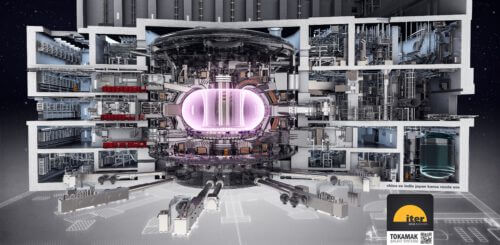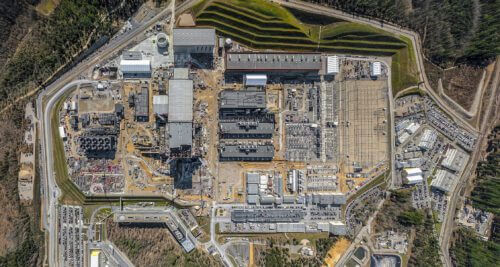An ambitious international venture seeks to harness the power of nuclear fusion to produce clean energy. If everything works according to the plans, in five years it will be operational (and in 15 years it may even start generating electricity)
Racheli Wax, Angle - Science and Environment News Agency

These days, when summer is gradually becoming a reality in the field, we are exposed more and more to the power of the sun, which produces enormous amounts of light and heat every day and without which life on earth, as we know it, would not be possible.
We also use the sun's radiation to create solar energy, of course, but there are those who indicate an even more ambitious goal: for several decades, human attempts have been made in various parts of the world to effectively reproduce the process of nuclear fusion, the mechanism through which energy is created in the core of the sun, and thus provide humanity with unlimited quantities Electricity is caught in a clean way. So far there has been no significant success in this area, but ITER, a huge international project created for this purpose, is now in advanced stages of construction, and if everything progresses successfully according to plan, it may turn science fiction into reality - and provide energy from nuclear fusion as early as 2035.
Nuclear fusion is the opposite process to nuclear fission - the mechanism that activates the atomic bomb and is currently used to generate electricity in nuclear power reactors. In nuclear fission, a large nucleus of a single, large, unstable atom (uranium or plutonium) is split into lighter and smaller atomic nuclei while emitting neutrons into their surroundings, which leads to a chain reaction in which many more atomic nuclei are fissioned and a tremendous amount of energy that was contained in them is released.
In nuclear fusion, on the other hand, two nuclei of hydrogen atoms (each of which has one proton) separate from their electrons and combine due to the tremendous temperature, density and pressure conditions in the core of the sun into one atomic nucleus of helium (which has two protons and two neutrons). In the artificial process that the scientists are trying to create, hydrogen isotopes (heavy forms of hydrogen with different numbers of neutrons), deuterium (one proton and one neutron) and tritium (one proton and two neutrons) are used. Thus, at the end of the nuclear fusion process, an excess mass is obtained, since a free neutron remains and the kinetic energy of this neutron is absorbed by a very thick lithium shell that surrounds the fusion chamber. The impact breaks down some of the lithium into helium and tritium (which is used as fuel to continue the fusion process), the mantle heats up and energy is supposed to pass from it through an internal cooling system to the electricity production process. A similar mechanism also underlies the operation of the hydrogen bombs (thermonuclear bombs), which are at least a thousand times more powerful than the atomic bombs dropped on Hiroshima and Nagasaki.
23 thousand tons at 150 million degrees
Throughout the last and current century, attempts were made to produce energy from nuclear fusion in over 200 reactors built for this purpose, but without success. In 1985, the President of the United States, Ronald Reagan, and the leader of the Soviet Union, Mikhail Gorbachev, determined that the issue required an international effort, and jointly announced the establishment of ITER. At first the name was an acronym for International Thermonuclear Experimental Reactor, and later the initials were dropped, and it was decided that ITER, the Latin word for "way", would be its full name.
The reactor, whose construction began in 1988 and is currently underway, is located in the town of Saint-Paul-lès-Durance in the Provence region of France. Its total cost is currently estimated at about 20 billion euros, invested by 35 countries, and it is expected to weigh about 23 thousand tons (three times that of the Eiffel Tower). Its parts, the heaviest of which will weigh almost 900 tons and the length of the largest of which will be 10.6 meters (the height of a four-story building), are transported from the nearest port on a 104-kilometer road specially adapted for the task.
The reactor will use deuterium and tritium, isotopes of hydrogen whose fusion is the most efficient for producing energy, and the temperature in it will be no less than 150 million degrees Celsius. According to the current ambitious plan, the reactor will be activated in 2025 and will gradually heat up, until in 2035 it can start providing energy.

The solution to all energy problems?
The ITER scientists are not the only ones trying to extract energy from nuclear fusion. Several commercial companies are also in various stages of striving for the same goal, among them the American start-up CFS (Commonwealth Fusion Systems), which recently raised 84 million dollars from investors in Europe and Asia.
Both ITER and the private companies will have to face significant difficulties on the way to the desired goal. "Nuclear fusion is a very complicated process," says Dr. Daniel Mader, a researcher and scientific consultant and one of the founders of the SP Interface company. "In order for it to succeed, conditions are needed that are similar to those that exist in the core of a star like the Sun, which include very high pressure and temperature. It is very difficult to create such a situation on Earth, because it requires the investment of huge amounts of energy."
According to Madar, scientists have managed to perform nuclear fusion in research facilities in the past - but the amount of energy that had to be invested in the process was much greater than what was produced from it.
However, if the efforts underway at ITER succeed despite the many obstacles, the global energy market will change greatly. "This will solve all the energy problems," says Madar. "This process makes it possible to extract a tremendous amount of energy from a minimal amount of material." According to him, a significant part of the potential of the process comes from the fact that the raw material required for it is hydrogen, the most common element in the universe, which exists on Earth in many compounds (like water). "The stock of fuel that can be used is endless," he says.
Another significant advantage of nuclear fusion, if it succeeds, is its high safety compared to other energy production methods, primarily the burning of fossil fuels (coal, oil and natural gas) - a process that causes the emission of huge amounts of greenhouse gases (especially carbon dioxide) into the atmosphere, which exacerbate the climate crisis even more, and as a result of which there is also widespread air pollution with respirable particles (PM2.5 PM10), nitrogen oxides and ozone sulfur and other pollutants.
Beyond that, nuclear fusion is also much safer than nuclear fission, which is, as mentioned, the method used in nuclear power plants today, and which in extreme cases can cause traumatic disasters when all safety systems fail (the most memorable of all is the Chernobyl disaster). "Unlike nuclear fission, in nuclear fusion there is no dealing with dangerous radioactive elements, which pose a risk to the environment and to humans after the process ends," says Madar. "There is no danger of nuclear radiation or nuclear waste."
Don't wait for miracles
In spite of all this, it must be remembered that the human race is still very far from the efficient production of energy from nuclear fusion, and that ITER is a very ambitious project and it is not known if it will actually be realized as promised in 2035. "There is no need to cancel the other programs to reduce greenhouse gas emissions and wait only for this," says Madar. According to him, it is important to continue investing in the development of renewable energies, such as solar energy, which already exist today and which can significantly help to reduce electricity production from polluting fossil fuels. "We must not wait for technological miracles that may happen in the future, when it may already be too late," he concludes.

4 תגובות
The skeptic
Even in 2050 I don't think there will be commercial miners.
Perhaps in a very optimistic scenario if there are no problems then it will be possible to produce energy with the help of fusion.
But for something commercial it's really not enough, it has to be economic as well.
And it's not easy at all.
The technology of fusion is talked about as if it were some magic solution, some kind of holy grail.
But the truth is far from that.
How much does something like this cost? How many judges does something like this need, what is the wear and tear of such a facility, and how many safety systems does it need.
The fact that there are not many nuclear reactors in the world is neither because of the quality of the environment nor because of a lack of raw material (uranium is really rare, but a very small amount is needed)
The cost of simple construction and operation is often too high. The safety systems, the experts, the audits and tests, it costs a lot of money.
If it was really economical, they would use it and not think about pollution.
In any case, even in the most optimistic scenario, this is only a partial solution. It is already clear that if it is possible to achieve energy efficiency in fusion it is only in very large plants.
Another thing, in recent years the cost of solar energy has been decreasing.
The main investment should be in energy saving and renewable energy
The safire project shows more zero-cost results than all these megalomaniac projects.
"In the last decades.."
For seventy years they have been pouring money without realizing it to create fusion "like in the sun".
Eddington argued that it would not be difficult to understand how the sun. When the theory fails, any attempt to build technology with it is also doomed to failure.
I don't know when you've heard of Ralph Jurgens, Hans Alfein. If not then too bad.
If everything works as hoped then what they will see
that it is feasible, there is also a lot of research on the way
And this reactor is not designed to supply electricity to the grid
These are only the feasibility of the fusion technology, meaning that it will give more energy than is invested in it,
The next step will be to build a prototype
and monitoring active fusion reactors
Probably a large part of those reading the article will no longer be here to see the commercial fusion reactors. We are talking about dates of 2050,
The article says:
"In nuclear fusion, on the other hand, two nuclei of hydrogen atoms (each of which has one proton) separate from their electrons and combine due to the tremendous temperature, density and pressure conditions in the core of the sun into one atomic nucleus of helium (which has two protons and two neutrons)." End quote.
It should be written: four nuclei of a hydrogen atom, etc., etc.
Also, they still don't know how it will work, but they already promise us that it will be safer than the current production methods??
Not acceptable to me to say the least!
But I wish them luck!
Good Day
Sabdarmish Yehuda